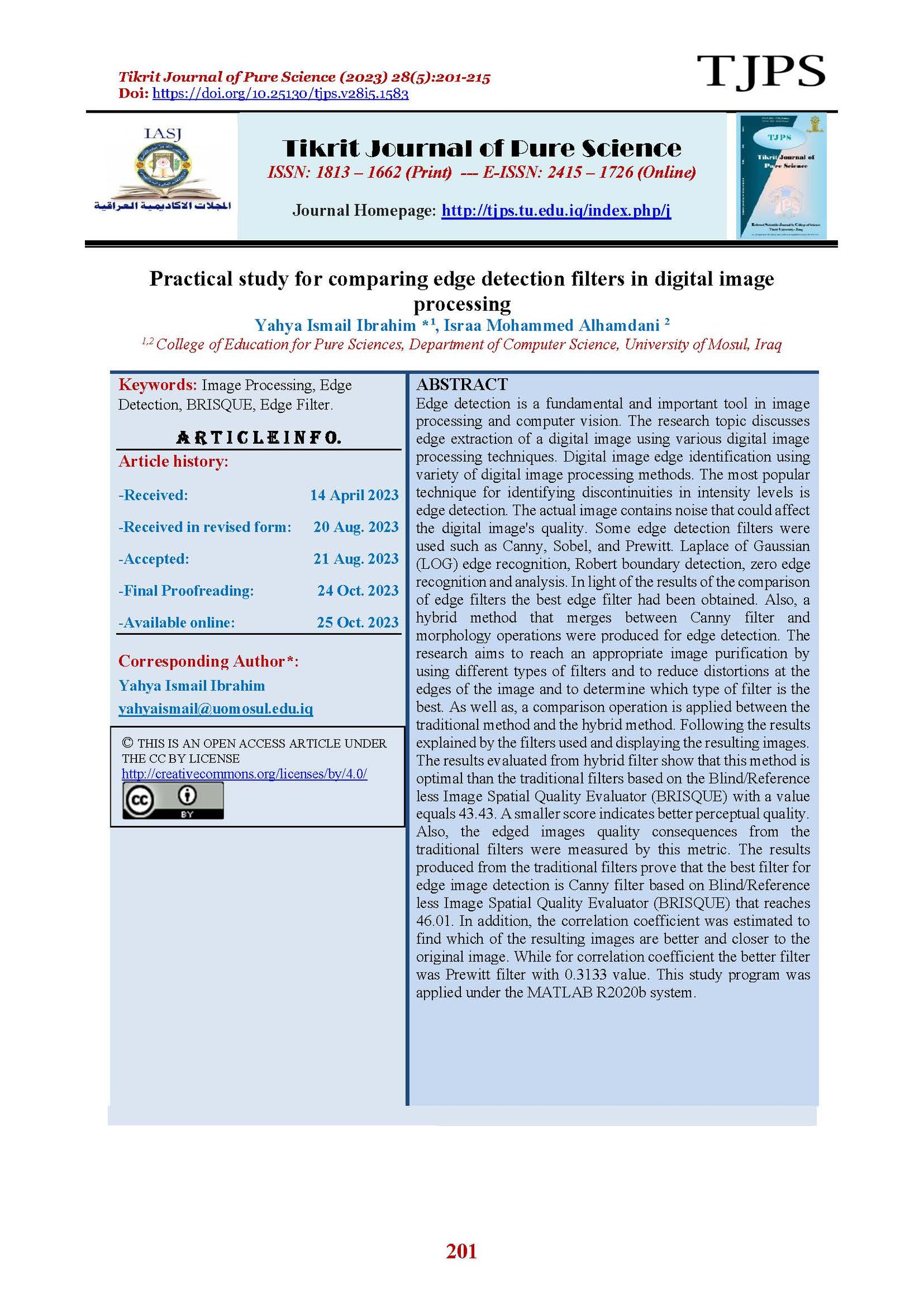Practical study for comparing edge detection filters in digital image processing
Main Article Content
Abstract
Edge detection is a fundamental and important tool in image processing and computer vision. The research topic discusses edge extraction of a digital image using various digital image processing techniques. Digital image edge identification using variety of digital image processing methods. The most popular technique for identifying discontinuities in intensity levels is edge detection. The actual image contains noise that could affect the digital image's quality. Some edge detection filters were used such as Canny, Sobel, and Prewitt. Laplace of Gaussian (LOG) edge recognition, Robert boundary detection, zero edge recognition and analysis. In light of the results of the comparison of edge filters the best edge filter had been obtained. Also, a hybrid method that merges between Canny filter and morphology operations were produced for edge detection. The research aims to reach an appropriate image purification by using different types of filters and to reduce distortions at the edges of the image and to determine which type of filter is the best. As well as, a comparison operation is applied between the traditional method and the hybrid method. Following the results explained by the filters used and displaying the resulting images. The results evaluated from hybrid filter show that this method is optimal than the traditional filters based on the Blind/Reference less Image Spatial Quality Evaluator (BRISQUE) with a value equals 43.43. A smaller score indicates better perceptual quality. Also, the edged images quality consequences from the traditional filters were measured by this metric. The results produced from the traditional filters prove that the best filter for edge image detection is Canny filter based on Blind/Reference less Image Spatial Quality Evaluator (BRISQUE) that reaches 46.01. In addition, the correlation coefficient was estimated to find which of the resulting images are better and closer to the original image. While for correlation coefficient the better filter was Prewitt filter with 0.3133 value. This study program was applied under the MATLAB R2020b system.
Article Details

This work is licensed under a Creative Commons Attribution 4.0 International License.
Tikrit Journal of Pure Science is licensed under the Creative Commons Attribution 4.0 International License, which allows users to copy, create extracts, abstracts, and new works from the article, alter and revise the article, and make commercial use of the article (including reuse and/or resale of the article by commercial entities), provided the user gives appropriate credit (with a link to the formal publication through the relevant DOI), provides a link to the license, indicates if changes were made, and the licensor is not represented as endorsing the use made of the work. The authors hold the copyright for their published work on the Tikrit J. Pure Sci. website, while Tikrit J. Pure Sci. is responsible for appreciate citation of their work, which is released under CC-BY-4.0, enabling the unrestricted use, distribution, and reproduction of an article in any medium, provided that the original work is properly cited.
References
[1] R. C. Gonzalez and R. E. Woods, “Digital image processing, global edition,” Digit. Image Process. Glob. Ed., vol. 19, 2018.
[2] V. Tyagi, "Understanding digital image processing". CRC Press, 2018.
[3] E. R. Dougherty, "Digital Image Processing Methods". CRC Press, 2020.
[4] D.-W. Lee and S.-H. Lee, “Edge Detection using Cost Minimization Method”, J. Internet
Things Converg., vol. 8, no. 1, pp. 59–64, 2022, doi:10.20465/KIOTS.2022.8.1.059. [5] G. T. Shrivakshan and C. Chandrasekar, “An Edge Detection Method Based on Local Gradient Estimation: Application to High-Temperature Metallic Droplet Images”, Applied. Sciences., 12(14), 6976, 2022, doi:10.3390/app12146976.
[6] R. M. Yousaf, H. A. Habib, H. Dawood, and S. Shafiq, “A comparative study of various edge detection methods” , 14th International Conference on Computational Intelligence and Security (CIS), pp. 96–99, 2018, doi:10.3390/electronics11142118.
[7] J. N. Archana and P. Aishwarya, “Analysis of Different Image Enhancement and Feature Extraction Methods”, Mathematics 10(14), 2407, 2022, doi:10.3390/math10142407.
[8] Michela Lecca , Alessandro Torresani, Fabio Remondino, “Comprehensive evaluation of image enhancement for unsupervised image description and matching”, The Institution of Engineering and Technology 2020, IET image Processing, 2020, doi: 10.1049/iet-ipr.2020.1129.
[9] Vikram M, “Comprehensive Guide to Edge Detection Algorithms”, Published on August 7, 2022 and Last Modified on August 9th, Ebook: Machine Learning Simplified, 2022. [10] Bhardwaj, Saket, and Ajay Mittal. "A survey on various edge detector techniques." Procedia Technology, vol. 4, pp. 220-226, (2012), doi: 10.1016/j.protcy.2012.05.033.
[11] Xie, Saining, and Zhuowen Tu.,"Holistically-nested edge detection.", Proceedings of the IEEE international conference on computer vision. 2015.
[12] R. Sun et al., “Survey of Image Edge Detection” , 2022, doi:10.3390/rs14153728.
[13] A. Rijuvana Begum , S. Jana “Edge Detection Using Modified Third Order Edge Mask for Grayscale Medical Image Segmentation”, Part of the Advances in Intelligent Systems and Computing book series (AISC,volume 1163), 2020.
[14] N. Mathur, S. Mathur, and D. Mathur, “A novel approach to improve sobel edge detector”, Procedia Comput. Sci., vol. 93, pp. 431–438,2016, doi:10.1016/j.procs.2016.07.230
[15] http://www.roborealm.com/help/Prewitt.php [Internet]
[16] A. Mittal, A. K. Moorthy, and A. C. Bovik, “Blind/referenceless image spatial quality evaluator”, in 2011 conference record of the forty fifth asilomar conference on signals, systems and computers (ASILOMAR), 2011, pp. 723–727.
[17] I. Stępień and M. Oszust, “A Brief Survey on No-Reference Image Quality Assessment Methods for Magnetic Resonance Images”, J. Imaging, vol. 8, no. 6, p. 160, 2022, doi:10.3390/jimaging8060160
[18] C. G. Rafael, E. W. Richard, L. E. Steven, R. Woods, and S. Eddins, "Digital image processing using MATLAB", Tata McGraw-Hill, 2010.
